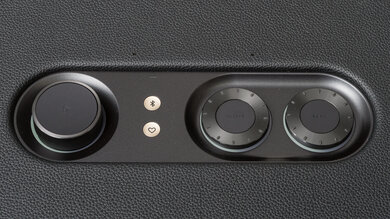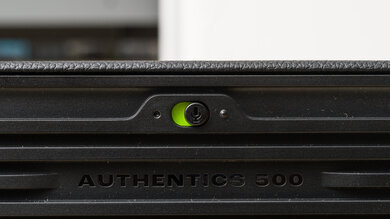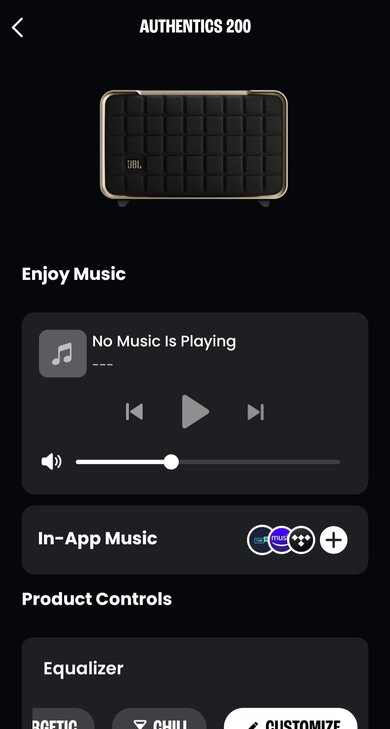The JBL Authentics 500 is a premium home speaker that combines a retro design inspired by classic JBL speakers with present-day smart features like voice assistant support with built-in Alexa and Google Assistant. With three tweeters, three mid-range drivers, and a built-in subwoofer, it's technically a 3.1 sound system. It also supports Dolby Atmos Music through compatible streaming services like Tidal.
Our Verdict
The JBL Authentics 500 is good for music. Its Self-Tuning room correction tool automatically adjusts the speaker's sound based on your room's unique acoustics. With it on, its sound is fairly even and balanced, making it suitable for many different music genres. Plus, it's quite customizable, with bass and treble knobs on the speaker as well as presets and a graphic EQ in the JBL One companion app. It gets quite loud, too, albeit with some compression at max volume.
-
Graphic EQ.
-
Gets loud.
-
Some compression at max volume.
The JBL Authentics 500 is adequate for videos and movies. While this speaker can't replicate the deep rumbles of explosions in high-stakes action scenes, the balanced midrange ensures dialogue is detailed and easy to understand. You can connect this speaker over Apple AirPlay, Bluetooth, or Wi-Fi for video playback from your devices. Its latency is on the higher end over Bluetooth, so you'll want to stick with AirPlay to avoid lip-synching issues.
-
Graphic EQ.
-
Gets loud.
-
Some compression at max volume.
-
Higher latency on Bluetooth.
The JBL Authentics 500 is decent for podcasts. Voices are reproduced with clarity, so it's easy to follow along with the conversation. The speaker's loud, too, which is great for filling up larger spaces with sound. That said, it's not the most portable, so you can't bring it to different rooms of your home while listening to longer episodes.
-
Graphic EQ.
-
Gets loud.
-
Some compression at max volume.
-
Wired-only design.
The JBL Authentics 500 is excellent for voice assistant support. Built-in Alexa and Google Assistant offer great performance, even if you're further away from the speaker. You can use both assistants at the same time, too. However, Alexa performs better than Google Assistant at picking up on your commands in noisier environments. For more private moments, you can always mute the microphone.
-
Gets loud.
-
Microphone mute button.
-
Some compression at max volume.
This wired-only speaker isn't intended for outdoor use.
- 7.7 Music
- 6.9 Videos/Movies
- 7.0 Podcasts
- 8.6 Voice Assistant
- 7.3 Outdoors
Changelog
-
Updated Apr 14, 2025:
We mentioned the Harman/Kardon Onyx Studio 9 in the Battery section of this review.
-
Updated Feb 27, 2025:
We've updated the text for clarity and accuracy.
-
Updated Feb 18, 2025:
We retested the speaker after updating to firmware 24.43.21.50.00. The text has been edited to reflect an upgraded 7-band graphic EQ and the addition of ambient audio within the app.
- Updated Dec 04, 2023: Thanks to user feedback, we identified a faint issue with static, which is described in the Frequency Response Accuracy box.
- Updated Nov 27, 2023: Review published.
Check Price
Differences Between Sizes And Variants
This speaker is available in Black, and you can see the label here for the model we tested.
If you come across another version of this speaker, let us know in the comments, and we'll update our review.
Compared To Other Speakers
The JBL Authentics 500 is the more premium alternative to other speakers in the Authentics lineup, like the JBL Authentics 200. Compared to the 200, this speaker is larger and louder, and it supports features like Dolby Atmos Music through compatible streaming platforms. It's a wired-only device meant for home use, and its wide array of customization tools gives you lots of control over its sound.
See also our recommendations for the best home speakers, the best smart speakers, and the best JBL speakers.
The Sonos Era 300 and the JBL Authentics 500 are both premium home speakers with built-in voice assistant support. Depending on your listening habits, you may prefer one over the other. The JBL has better dynamics, whereas the Sonos has a better soundstage performance. Some listeners may prefer the JBL's retro design. If you already own Sonos products, you can integrate them with the Sonos Era, which is nice.
The JBL Authentics 500 is a more feature-packed speaker than the Sonos Five. Unlike the Sonos, the JBL has built-in voice assistant support, so you don't need to connect a third-party device. It gets louder and supports Bluetooth, too. However, it can't bring as much low-bass as the Sonos.
The JBL Authentics 500 is a larger and more premium cousin of the JBL Authentics 200. While the 200 is a good option if you're low on space and has many of the same features as the 500, it can't get as loud or reproduce as much low-bass. Plus, it lacks support for Dolby Atmos Music.
The Bose Smart Speaker 500 and the JBL Authentics are wired home speakers with different strengths. They're both similarly well-built and have great, intuitive control schemes. However, the JBL has a more balanced default sound and can get louder with less compression artefacts present at max volume. That said, the Bose has a better voice assistant performance and can pick up commands even in noisy environments. It also has better directivity, so audio sounds consistent from different listening angles.
The JBL Authentics 500 is better than the Klipsch The Three II. They're both retro-style home speakers, but only the JBL offers built-in voice assistant support and a companion app with plenty of customization features. It also brings more low-bass and, unlike the Klipsch, offers Wi-Fi connectivity.
The JBL Authentics 500 is better than the Bluesound PULSE 2i. The JBL offers built-in voice assistant support, unlike the Bluesound, which requires a third-party device. Plus, it reproduces more bass. Its graphic EQ is more comprehensive than the Bluesound's bass and treble adjustments, which is handy for switching up its sound.
The JBL Authentics 500 and Harman/Kardon Onyx Studio 9 have different strengths. The JBL is quite a bit larger than the Harman/Kardon, so it unsurprisingly gets much louder. But the Harman/Kardon puts up a sporting fight on the frequency response front, offering about as much mid-bass punch as the larger speaker. The Harman/Kardon is also battery-powered and easy to carry around with you, though we wouldn't take it outside as it lacks an IP rating against water and dust ingress. But the JBL has a built-in mic, so it's the one to choose if voice assistant support is crucial to you.
Test Results
The speaker is well-built overall. The dials and controls feel good to the touch, and the metallic gold accents and faux leather wrapping give it a premium finish. A tight-knit mesh covers the plastic 'Quadrex' grille in front of the speaker, which helps protect the drivers inside. It's elevated on rubberized feet to give the subwoofer space. The plastic on the back isn't as high-quality, but you aren't likely to see it much.
The controls are simple and easy to use. On top of the speaker, you'll find dials to control the bass, treble, and volume. Firmware update 24.43.21.50.00 upgraded the graphic EQ from 5 to 7 bands. Now, the bass dial affects frequencies at 125 Hz and below, while the treble dial affects frequencies at 8 kHz and above. They're backlit, giving you a visual indication of the bass/treble/volume levels as you adjust them. The volume dial doubles as a play/pause button for your audio, and you can also press it twice to skip to the next track or three times to go back to the previous track. Between the dials, there's a Bluetooth pairing button and a heart-shaped 'Moment' button, which you can use to quickly access a playlist or ambient audio after presetting them in the app. The microphone mute button is on the back of the speaker.
Like many premium speakers on the market, the JBL Authentics 500 includes a room correction tool to optimize its sound based on your room's unique acoustics. Its Self-Tuning feature activates automatically each time you connect the speaker to power and begin audio playback, so you don't need to press any buttons to start it. The process takes about three minutes and works as long as the microphone is on.
This speaker brings extra emphasis in the high-bass to low-mid range, adding some warmth to the mix. The rest of the mid-range is fairly even and balanced, so voices and lead instruments are clearly reproduced. To switch up its sound, you can adjust the speaker's bass and treble or use the graphic EQ in the JBL One app, which has been updated from 5 to 7 bands in a recent firmware update. Overall, it's suitable for listening to many different music genres, though, as our users have pointed out, some low-level static is audible in certain scenarios. It persists after updating the speaker's firmware and completing a factory reset. You notice it most on lower volumes, though it goes away after a few seconds on most sources, such as Bluetooth, AirPlay, and Google Cast. On Spotify Connect. However, the faint sound of static is present after you pause your music.
This stereo speaker has a front-facing design. You don't get consistent sound all the way around the speaker since it lacks a 360-degree configuration. Still, it's more than suitable if you place it on a shelf or a countertop, with the back side of the speaker facing a wall.
This speaker supports Dolby Atmos content over Wi-Fi streaming with compatible apps like Tidal, which requires an additional paid subscription. This feature brings a wider, more all-around feel to audio tracks. In general, voices are pushed back a little in the mix when you listen to music, but the trade-off is worth it if you want a more immersive sound.
This speaker is loud enough to fill larger rooms with sound. However, you notice some compression as you push it to max volume, especially in the bass range.
While there's no battery, the speaker does feature an auto-standby mode that activates if it's inactive for ten minutes. You can wake it up by pressing a button, playing music, or plugging into an input. If you're interested in a battery-powered home speaker that you can carry around with you from room to room, consider the Harman/Kardon Onyx Studio 9.
This speaker has built-in support for both Alexa and Google Assistant. You can use both voice assistants simultaneously, and the LED status light even displays different colors for each—blue for Alexa and white for Google Assistant. Both can easily pick up your commands from further away. Alexa does better in noisy environments, though.
The JBL One app is a handy way to control the speaker from your mobile devices. In the app, you can control music and voice assistant settings. There's a graphic EQ to switch up the speaker's sound, which has been upgraded from a 5-band EQ to a 7-band EQ with firmware 24.43.21.50.00. With this update, the speaker is also Roon Ready and has support for Spotify HiFi, which has yet to be released. You can also link a playlist from a compatible streaming service to the Moment button or choose an ambient audio selection instead. The app also allows you to connect to other compatible speakers to spread audio throughout multiple rooms in your home. With this firmware update, you can now connect two JBL Authentics 500 speakers to create a stereo pair. Check out a video of the app for more details.
You can wire devices to the speaker over an AUX connection. It also has an Ethernet port. You can use the USB port to charge other devices or playback audio from a USB storage drive, though it doesn't let you playback audio from a device like a computer.
You can connect the speaker to up to two devices simultaneously via Bluetooth. Its range is impressive, so your devices stay connected even from far away. A recent firmware update adds AAC codec support, which helps improve audio quality over Bluetooth. That said, latency is on the higher side, so you notice some lip-synching delays if you try to stream videos or movies to the device.
This Wi-Fi-compatible speaker is handy for those who want to connect easily with Apple or Google devices since it supports both AirPlay and Chromecast. That said, Chromecast seems to work only with audio content like music and specific Chromecast-enabled apps like Spotify. Therefore, we couldn't perform our video latency test over Chromecast. Let us know in the comments if you have a similar experience with this speaker.
Comments
JBL Authentics 500: Main Discussion
Let us know why you want us to review the product here, or encourage others to vote for this product.
This product has been merged with Shark ION Robot Vacuum, Wi-Fi Connected with Bonus. Follow the discussion here.


































